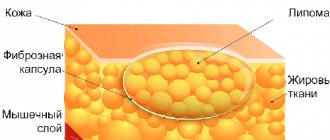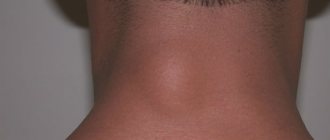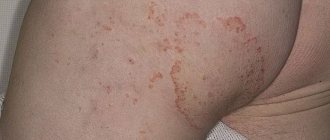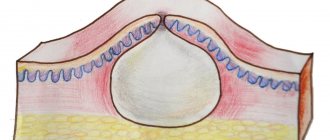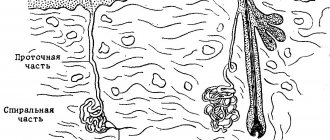Enlarged fat tissue can cause discomfort and pain. Lipoma on the buttock occurs for unknown reasons. Possible factors for its occurrence are hormonal imbalance, dysfunction of the thyroid gland, or disruption of enzymes in fatty tissues. The disease may be asymptomatic or accompanied by pain when growing or pressing on the tubercle. It is desirable to eliminate the tumor through surgery to avoid complications, inflammatory processes and tissue necrosis. Prevention of the disease helps to reduce gluteal lipoma.
Wen often grows in an “inconvenient place” - on the butt, which brings discomfort to life.
What it is?
Gluteal lipoma is a benign formation, a wen on the butt. Occurs regardless of condition or age, and is safe for health. Women aged 30 to 50 are at risk. Wen can appear in any area of the body (back, neck, abdomen, knee, etc.), located in adipose tissue. Less commonly, they appear in the stomach, intestines, mammary gland, brain, bone tissue, and chest cavity. Highlight:
- lipofibroma - the structure of the lipoma is soft, located in adipose tissue;
- angiolipoma - contains numerous blood vessels;
- fibrolipoma - it includes a combination of adipose and fibrous tissue, hard and dense;
- myolipoma - consists of smooth muscle fibers;
- myelolipoma - rare, located in the retroperitoneal region or in the pelvic area, adrenal glands, consists of adipose and hematopoietic tissue.
According to the structure, there are diffuse and nodular types of lymphoma. The first does not have a shell and is accompanied by growth in tissues. The second is similar to a node covered with a capsule that divides the fat cell. The fatty tissue is not attached to the tissue, so it easily changes its position during palpation. The diameter is also different, often reaching sizes from 10 mm to 50 mm.
A fatty area on the butt can grow due to hormonal imbalance, skin inflammation or other factors.
Causes of manifestation
Not a single specialist undertakes to state for what exact reasons a lipoma occurs under a person’s skin. This may be a genetic factor or a malfunction of fat cells. The formation can grow against the background of a malfunction of enzymes or mechanical damage to certain areas of the body. Hormonal imbalance can cause tumor formation between tissues and uneven distribution of fat under the skin. Buttocks can appear due to liver disease, diabetes, dysfunction of the brain, pituitary gland or thyroid gland. With diseases of the pancreas and metastases in the lungs, there is a high probability of lymphoma. Malignant alcohol consumption can aggravate the situation.
Lipoma symptoms
Gluteal lipoma may not have any symptomatic manifestations on the human body. In this case, the tubercle is not detected upon palpation. Fatty deposits that appear in the gluteal region can cause pain due to compression of nearby veins and nerve endings. If the tumor is located on the nerve trunk, then when pressed, a stabbing or cutting sensation is noticeable. Signs of lipoma:
- the presence of a lump, node or bump on the body under the skin;
- the structure of the formation is soft, which can be felt when pressed;
- movement of the tubercle when pressed under the skin;
- change in shape due to heaviness, appearance of a “leg”.
A solid structure indicates the presence of fibrous tissue. It does not have clear contours or boundaries. Only histological examination can give an accurate description of the growth.
Gluteal lipoma can cause pain, itching, and also cause extensive suppuration.
Locations
The danger of formation is the occurrence of negative consequences of an advanced pathological process:
- Lipomatosis is characterized by frequent relapses. Removal does not guarantee complete recovery.
- Inflammatory changes occur after mechanical irritation. Inflammation of the wen is accompanied by pain, redness, and the appearance of pus.
- The damage ends with the addition of bacterial flora. The occurrence of a pathological process is associated with a violation of the integrity of the wen on the butt. The contents of the capsule provide a favorable environment for the growth and reproduction of pathogenic microorganisms.
Lipoma is not a malignant neoplasm and does not pose a threat to human health. Sometimes circumstances are not in the patient’s favor when a person tries to remove a wen on his own. The infection enters the wound and produces changes in the behavior of the growth, which begins rapid growth and development.
Opening tumors at home is strictly prohibited. Without knowing the structure and nature of the tumor, you can doom yourself to irreversible processes in the disease. Only a specialist, through research and analysis, can determine whether the formation is malignant. How to treat and get rid of tumors must be discussed with a surgeon, whose knowledge and experience will help you find the appropriate method for each individual case.
- Lipomatosis is characterized by frequent relapses. Removal does not guarantee complete recovery.
- Inflammatory changes occur after mechanical irritation. Inflammation of the wen is accompanied by pain, redness, and the appearance of pus.
- The damage ends with the addition of bacterial flora. The occurrence of a pathological process is associated with a violation of the integrity of the wen on the butt. The contents of the capsule provide a favorable environment for the growth and reproduction of pathogenic microorganisms.
Wen on the leg can be localized in various places. According to their location zone, they are divided as follows:
- Wen on the buttock. It is characterized by the likelihood of painful sensations, which is due to frequent injury.
- Wen on the foot. It is formed against the background of being overweight and wearing uncomfortable shoes. Lipoma of the foot often causes discomfort when walking.
- Lipoma on the thigh. Most often, subcutaneous wen forms in this area of the leg.
Lipomas of muscle tissue often form in the area of the calf muscle. They can cause pain, interfere with walking, and lead to limitation of physical activity.
Complications with lipoma
The main problem that lipomas create is deterioration in appearance; they become a kind of skin defect. Its growth can continue, causing discomfort and complexes in the owner. The worst situation is its pressure on the nearby internal organs of the pelvis, nerve endings, which leads to a malfunction of the organs. In chronic stages, the sebaceous glands become deformed. In some cases, lipoma inflammation provokes the development of cancer cells. The difficulty lies in the fact that, increasing in size, the seal can destroy tissue, create swelling and block normal blood supply. A lipoma of the gluteal muscle can become inflamed and cause pain, degenerate into liposarcoma and displace nearby tissues. To avoid complications, you need to start treatment in a timely manner.
Reasons for appearance
Wen on the buttock most often occurs in patients who have a genetic predisposition to it. If close relatives have already been diagnosed with lipomatosis, in a child, regardless of his gender, in adolescence or adulthood, lipoma will begin to develop rapidly as soon as one of the risk factors comes into play:
- gluteal lipoma is formed due to serious disorders of lipid metabolism, this is one of the most common causes of lipomas;
- hormonal disbalance;
- the result of malfunction of the mechanism for regulating fat formation;
- regular violation of basic hygiene rules.
A true lipoma has a lobular structure, which is due to the peculiarities of its development according to the type of tumor. The entire thickness of the formation is a derivative, a “clone” of one cambial cell.
Who is the doctor?
The only method of getting rid of lipoma on the buttock is removal. Consequently, such an operation is performed exclusively by a surgeon. He also transfers the cut material for diagnostics. A therapist can also diagnose a lipoma, but treatment is only supposed to be surgical. If the subcutaneous node has malignant cells, then the oncologist also conducts observation.
The surgeon finds out the root cause of the gluteal lipoma and prescribes a measure to eliminate the disease.
What is the danger
In the vast majority of clinical cases, lipoma on the leg is absolutely safe for health. Problems that arise due to the appearance of wen include cosmetic defects, as well as possible discomfort when walking or performing other movements.
However, there are also some risks. For example, the appearance of a muscle wen can lead to damage to muscle tissue. With constant trauma to lipomas, inflammatory processes may develop, as well as the transformation of a benign tumor into a malignant one. It is also recommended to be sure to remove wen from the extremities on the feet, as their appearance can lead to impaired mobility.
READ ALSO: How long does it take for an allergic rash to go away?
Diagnosis of the disease
At the time of palpation, the location, size, consistency and mobility of the gluteal wen are examined. The sensations when pressing on the patient's tubercle are determined, the skin over the formation is examined and a number of questions are asked about the symptoms. X-rays are used for detailed diagnosis. More reliable data is provided by computed tomography, which clearly identifies even slightly fatty compaction. Ultrasound is often used to detect nodes. Biopsy and cytological tests can check whether the tumor is benign. Before the operation is scheduled, the patient's blood and urine are tested for the presence of viral infections, especially HIV.
Treatment and prevention of wen on the buttock
If the gluteal tumor grows or painful symptoms appear, the skin around it becomes inflamed, or it is simply uncomfortable to wear, the lipoma should be treated immediately. There are radical and traditional methods for eliminating wen. Radical ones include:
- surgical removal;
- liposuction;
- laser removal;
- removal by endoscope.
The most popular and most easily controlled method is cutting out the node (surgery). In this case, a small incision is made on the skin of the buttock, the contents are squeezed out, the remains of the capsule are scraped out to prevent relapse, and the wound is sutured. The laser gives the best cosmetic effect, preventing the appearance of large scars and scars. During liposuction and endoscopy, the contents of the lipoma are pulled out, but the capsule remains.
Traditional methods
Traditional methods are based on compresses, lotions using honey, golden mustache, ivy, bee onions, juice or Kalanchoe leaves. The use of such drugs can only be carried out with the permission of a doctor. The effectiveness of recipes “from grandmothers” is unknown; before you start using them, you should make sure that it is definitely a gluteal lipoma. A popular compress is a combination of honey and vodka, or ivy and vodka. This mixture is applied to a gauze bandage and applied to the site of formation. The average course of such therapy is 15 days.
Hygiene and a healthy lifestyle are the best measures to prevent wen on the butt.
Therapy for buttocks
Since most often lumps on the buttock occur as a result of a long course of injections, let’s take a closer look at how you can get rid of them in this case.
Formations on the buttock after injections
If after intramuscular injections you feel unpleasant symptoms and feel lumps, it is important to start taking action to get rid of them.
If the lump does not dissolve after the injections, to remove it, you can use the following drugs:
- Heparin ointment will help get rid of bumps on the buttocks in a week or two. The drug relieves pain well, soothes the skin and relieves inflammation. It is recommended to apply the ointment to clean skin three times a day;
- To restore damaged tissues, as well as destroy microbes, seals can be lubricated with Vishnevsky ointment. The drug is best used in the form of compresses. The duration of each procedure is three to four hours;
- To resolve the accumulated blood around the injection site, you can apply lotions with Dimexide. Mix one part of the drug with ten parts of water. Apply the product in the form of a lotion to the affected area for half an hour. After removing the compress, wipe the skin with alcohol. Repeat the procedures twice a day;
- To relieve swelling and inflammation in a compacted area after an injection, it is recommended to apply Troxevasin to the skin. The drug is applied twice a day and gently rubbed into the muscles with light massage actions;
- The formation can be lubricated with iodine. The antiseptic is applied to the skin in the form of a mesh. It is important to ensure that the development of inflammation is not missed, since iodine only acts as a disinfectant;
- Before going to bed, you can apply a cotton pad soaked in Magnesium sulfate to your buttock with an adhesive plaster.
To help the lump on the buttock dissolve faster after injections, you can use a disinfecting blue lamp or a special electric massager.
To resolve lumps on the buttocks, you can use traditional medicine methods:
- Place the aloe leaf in the refrigerator for 24 hours. After a while, cut and wrap in gauze. Apply the product to the bump for several hours, securing it with an adhesive plaster or bandage;
- Before going to bed, lubricate the compacted areas of the skin on the buttocks with a small amount of honey;
- To eliminate swelling and inflammation, you can apply grated potatoes wrapped in a wide bandage to the swelling;
- Wrap a lightly torn cabbage leaf around your buttock overnight. The juice of the plant will relieve inflammation and also destroy germs. Cabbage leaves can be replaced with burdock;
- Lubricate the seal with rich cream, and then apply a little alcohol;
- Apply pickled cucumber slices to the formation for eight hours. This remedy will relieve pain and inflammation.
You can also apply heated cottage cheese to the formation in the form of a compress, a cake made from butter, fresh yolk and honey. It is recommended to use any folk remedy after consultation with a doctor.
Therapy for lumps caused by cancer
If there is a suspicion that the lump in the buttock area may be of monological origin, the patient needs to undergo ultrasound, radiography, computed tomography and other studies. It is also necessary to carefully examine the pathological tissue and perform a cytological and histological analysis of the collected material.
Therapy of cancerous formations is carried out using cryodestruction or radiation therapy or chemotherapy.
The exact type of treatment for the pathology is determined by the doctor after carefully studying the research results and the patient’s condition.
